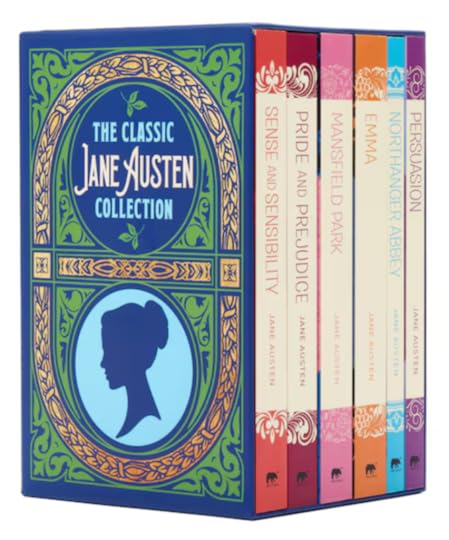Reading Sense and Sensibility Through the Framework of Birth Order, by Ria Harvie
One of the things I noticed when reading Sense and Sensibility, and earlier in the year Pride and Prejudice, was that the siblings act very much like they are supposed to based on which sibling they are. What I mean by that is that my generation has a bunch of designated traits for each different sibling in the order of siblinghood (i.e. eldest, youngest, middle child or only child). The traits don’t fit for everyone, but generally the people in each division have the traits of that section. It also generally evens out as people get older and more mature, but for teens and young adults, it’s often easy to pick out where people rank in their families, simply based on their personalities.

(From Sarah: I’m delighted to introduce Ria’s guest post! Ria will be starting grade ten in the fall and she has just read Sense and Sensibility for the first time. This is the fifteenth guest post in “A Summer Party for Sense and Sensibility,” which began on June 20th and will continue through to the end of the summer. You can find all the contributions to the blog series here. I hope you’ll join the conversations about S&S in the comments here and on social media: #senseandsensibilitysummer. Thanks for celebrating Jane Austen’s first published novel with us!)
Eldest siblings tend to have a wide skill set. They are independent, protective, and aren’t the greatest at sharing their emotions. A lot of the elder siblings I know are the quiet ones of their friend group. They can be reckless, but in a friend group it’s often the elder sibling who is the mature one. They are always the one who is given responsibility in situations.

Middle children are the people who lead from the back. They don’t tend to expect praise or attention, and they are the type of people who are really smart and achieve a lot but might not get noticed for it. Depending on the person, they might be the type that’s always looking for someone who gives them the praise that their siblings get, or they are used to it and take praise as it comes.
Younger siblings love praise. They are often the most energetic siblings, even if they aren’t popular or extraverted (though they are still often people people). They generally are those people who don’t help out until they are asked too, but can be helpful once you ask them. They tend to be really really good at a few things. They love attention, and they are usually the least responsible, because they’ve never had to be responsible.

Only children are the most spoiled. That’s a stereotype, but it’s true that they are more likely to be the spoiled one out of the four types. They, like younger siblings, often need to be asked to help before they step in. An only child is used to attention, and they don’t crave it like younger siblings. They’re also probably either the nicest person you know, or the most annoying. They can be really bad at reading people and interacting with people, though that can vary for each person.
Jane Austen writes characters that follow these formulas. It’s something I noticed when reading Pride and Prejudice, because in that book, the main sisters all fit so easily into the categories they belong in.

Jane is the eldest sibling, and she is the shyest of the bunch. When she’s given the chance to go and get married to this hot rich dude, she’s worried about leaving her family behind. There is only one person who really knows her (Elizabeth, of course) and she talks about her emotions in a sort of shy way.
Lydia, the youngest, is the opposite of Jane. She is emotional and attention seeking all the time, she is always energetic and she’s not the best with other people’s emotions because she doesn’t exactly get that they aren’t as good at sharing as she is. She charges into a relationship without thinking about the technicalities of money or anything like that. She’s never really had to do anything for herself, she’s her mother’s favorite, and she’s very passionate about the things that she’s interested in. She is a very extreme type of younger sibling.
Mary and Kitty are middle siblings, and they are the ones who are the most forgettable. They are kind of ignored by everyone, whether that is their family, the potential suitors in the story, or the readers. We don’t really hear a lot about Kitty’s academics, but Mary is very book smart and loves studying. They both feel a bit overshadowed by their younger and older sisters. They work for attention, Kitty by acting as much like Lydia as she can, and Mary by being as smart as possible, but they are still background characters in their family.
Elizabeth is less of an overlooked member of the family, which I think can be attributed to the fact that she is super nice and funny, but also that she has accepted that she’s not as gorgeous or pure as Jane or as popular as Lydia, and she is okay with that. She tends to be very supportive of Jane, at least, and if she’s not supportive of her other siblings for most of the book it’s because she finds them young and annoying. She very much “leads from the back” throughout the entire Lydia situation at the end, and supports her siblings during the whole endeavor, and Lydia afterwards, even though she doesn’t agree with what she did.
I’d also like to mention Mr. Darcy, who acts like an only child but sometimes an elder sibling, which seeing as he is twelve years Georgiana’s elder makes a lot of sense. He is spoiled and shy and doesn’t know how to interact with people. But he’s also really responsible and capable.

In Sense and Sensibility there are three sisters: Elinor, Marianne, and Margaret.
Elinor is the eldest, and she is independent and responsible. She is even more wary about talking about her feelings than Jane. She doesn’t say stuff unless there is a point; she shares her opinions but listens to others’ too. She thinks about things like money and property when she gets a chance at marriage. Pretty typical eldest.
Marianne, though, I don’t think really fits. See, she is the middle sibling. Elinor is 19, Marianne is 17, and Margaret is 13. But Marianne very much acts like a younger sibling. She loves attention, she’s irresponsible, she loves praise and flattery, she’s extroverted. She’s emotional (she’s the ‘Sensibility’ in the title). When she falls in love she wants to get married immediately, even though there are so many problems that would come with marrying Willoughby, and when he breaks her heart she bawls about it for a month. She, like Lydia, seems to be on the extreme side of younger siblings.
Except that she’s not. She’s the middle sister. Which was extremely frustrating to me, because it’s not just her character that makes her seem like a younger sibling, in the narrative, she is, for all intents and purposes, the youngest. One of two. Margaret, the actual youngest, has no importance in the plot. She’s not there for 90% of the story, and when she is there she doesn’t bring any importance to the scenes. There have been many moments where I’ve wondered why Margaret is there at all.
Margaret has already been discussed this year by Finola Austin in the article titled “What About Margaret? Reading Sense and Sensibility With Fresh Eyes”, so I won’t go further into her character, but I do wonder what the story would be like, if Marianne acted more like a middle sister, like Elizabeth. Would she have wanted to marry Willoughby so suddenly and without thought? Would she have spent those months pining about him before deciding that it wasn’t worth it? Would the relationship between her and Willoughby even have existed, or would it have been like Elizabeth’s attraction to George Wickham? Would Colonel Brandon have told her first about the scandal with Eliza? Would she have been able to get out of the relationship without heartbreak the way that Elizabeth did?
I think that the novel would have been very different, had Marianne behaved like a middle child.

Ria Harvie is from Halifax, Nova Scotia and will be starting grade ten in the fall. In her free time she enjoys reading and writing, and she’s interested in history and literature. She sent me the sunset photos, from Kincardine, Lake Huron. I took the picture of the bouquet of flowers (above), a recent present from my friends Abby and Melanie.

If you enjoyed this post, I hope you’ll consider recommending it to a friend. If you aren’t yet a subscriber, please sign up to receive future guest posts in “A Summer Party for Sense and Sensibility.” The next post, “Sense and Sensibility and Sewing,” is by Marilyn Smulders.
Here are the links to the last two posts, in case you missed them:
Mrs. Dashwood’s Journey of Growth in Sense and Sensibility, by Vic Sanborn
Time to Deliberate and Judge Edward Ferrars, by Deborah Knuth Klenck

Read more about my books, including Jane Austen’s Philosophy of the Virtues and Jane Austen and the North Atlantic, here.



